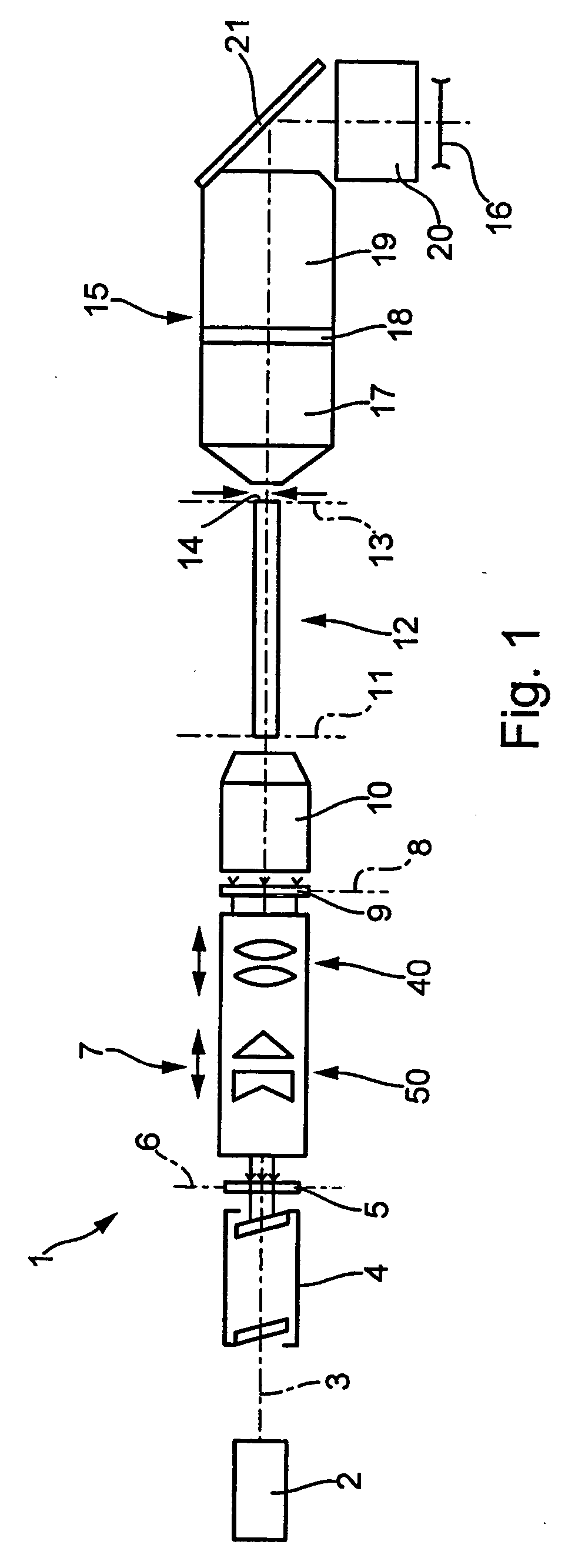Optical beam transformation system and illumination system comprising an optical beam transformation system
an optical beam and transformation system technology, applied in the field of optical beam transformation systems, can solve the problems of reducing the polarization-varying effect of conventional beam transformation systems, such as axicon systems, and further losses at downstream deflecting mirrors or polarization-dependent beam splitter layers, so as to reduce the polarization-varying
- Summary
- Abstract
- Description
- Claims
- Application Information
AI Technical Summary
Benefits of technology
Problems solved by technology
Method used
Image
Examples
first embodiment
[0123]FIG. 2 shows a substantially polarization-maintaining axicon system 250. It comprises a first axicon element 251 and a second axicon element 252, which is arranged downstream thereof in the direction in which the light runs and whose axial spacing can be infinitely adjusted by means of an adjusting device (not shown) and, if appropriate, can be reduced to a spacing of zero. The first axicon element 251 has a concave conical entrance surface 255 which forms the entrance surface and first axicon surface of the axicon system, as well as a substantially planar exit surface 256. The inclination angle α of the axicon surface, which is measured between a plane perpendicular to the optical axis and a tangent plane at the cone, is approximately 20° to 25°. The second axicon element 252 has a substantially planar entrance surface 257 and a convex conical exit surface 258 which forms the exit surface of the axicon system and at the same time its second axicon surface. The inclination ang...
third embodiment
[0128] In an axicon system 450 in FIG. 4, corresponding reference numerals are increased again by 100. Here, the first axicon element 451 has a concave conical entrance surface 455 and a convex spherical (or slightly aspheric, if appropriate) exit surface 456, while the subsequent second axicon element 452 has a concave spherical (or slightly aspheric, if appropriate) entrance surface 357 corresponding to the surface 456, and a conical exit surface 458. Because of the spherically curved intermediate surfaces 456, 457, whose spacing can be adjusted, the deflecting action, which leads to a radial redistribution of light intensity, further has superimposed on it a focusing action of the axicon system such that the radiation emerging from the exit surface 458 of the axicon system runs convergently. An axicon system with an overall “positive refractive power” is thus created. Here, again, the beam deflection is advantageously distributed over all four optical surfaces of the axicon syste...
fifth embodiment
[0130]FIG. 6 shows an axial top view of an axicon surface 655 of an axicon system 650 of a The axicon element comprises a plurality of separate individual elements which are arranged circularly about the optical axis and in each case have the form of wedges. Such a wedge element of triangular shape is marked by bold lines. The individual elements arranged in the shape of a rosette can be fixed on one another and thus form with an axicon surface a pyramid element which has a polygonal pyramid shape which is assembled from a plurality of planar pyramid facets 670 which border one another or are arranged at a slight spacing from one another. It is thereby possible to create a multiple prism with a number of prism elements which are arranged in a circular arrangement such that light which comes from a point light source arranged on the optical axis runs through the prism elements and after the passage a number of component beams which corresponds to the number of prism elements is pres...
PUM
 Login to View More
Login to View More Abstract
Description
Claims
Application Information
 Login to View More
Login to View More - R&D
- Intellectual Property
- Life Sciences
- Materials
- Tech Scout
- Unparalleled Data Quality
- Higher Quality Content
- 60% Fewer Hallucinations
Browse by: Latest US Patents, China's latest patents, Technical Efficacy Thesaurus, Application Domain, Technology Topic, Popular Technical Reports.
© 2025 PatSnap. All rights reserved.Legal|Privacy policy|Modern Slavery Act Transparency Statement|Sitemap|About US| Contact US: help@patsnap.com



